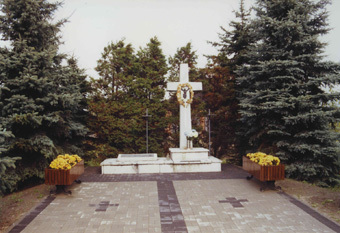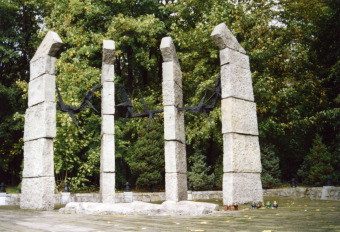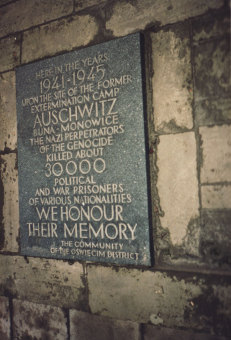Memorial Sites for the Buna/Monowitz Concentration Camp

© Matthias Naumann

© Matthias Naumann

former I.G. Auschwitz plant site, undated
© Ernest W. Michel
A few months after the liberation of the Buna/Monowitz concentration camp by the Red Army on January 27, 1945, the camp was closed, and in its place the village of Monowice, previously torn down, was rebuilt by the returning Polish inhabitants. At the site of the concentration camp remain only isolated traces of what shaped its image for three years. The local residents raised funds to erect a white stone cross and a plaque to commemorate those who were murdered in the camp. It has this inscription in Polish:
In memory of those who were murdered in the years 1941–1945 in Subcamp IV. The residents of Monowice.
At the edge of the grounds of the factory, which was continued as a Polish state-owned enterprise, the town of Oświęcim put up a monument to those murdered during the construction. It consists of four ultralarge stone columns, whose shape is reminiscent of the fence pillars of the concentration camps. Between them stretches a huge piece of barbed wire. In front of them, memorial plaques are set into the ground, with these words in a variety of languages:
Here in the years 1941–1945 upon the site of the former extermination camp Auschwitz Buna-Monowice the Nazi perpetrators of the genocide killed about 30 000 political and war prisoners of various nationalisties. We honour their memory: The community of the Oswiecim district.
The misleading reduction to political prisoners and POWs (90 percent of the inmates were imprisoned as Jews) reflects socialist discourse, with its reference to a generalized group of “victims of fascism.” Both memorials at the site of the camp clearly speak the language of those who initiated them: in the village, Catholic farmers; next to the factory, political representatives of socialist Poland.
In contrast, the corporate headquarters of I.G. Farben in Frankfurt am Main remained largely unchanged: After 1945, the place where board meetings were held and decisions were made served first as the headquarters of the U.S. Army’s European command. Since 2001 it has been used by the Goethe University to house its humanities departments. When the university moved into it in 2001, the Fritz Bauer Institute and the university dedicated a memorial plaque. Its text, which describes the history of the building and the close cooperation there between I.G. Farben and the National Socialist régime, frames a quotation from Monowitz survivor Jean Améry:
None of us can withdraw from the history of our people. The past should and must not “be allowed to rest,” otherwise it can rise up again and could become the new present.
There are a few other monuments that relate specifically to Monowitz; the only well-known one is the Mémorial en hommage aux déportés du camps de Auschwitz III Buna Monowitz at the Père Lachaise Cemetery in Paris, dedicated to the prisoners of the Buna/Monowitz concentration camp and its subcamps. It consists of a plaque and an iron sculpture that depicts emaciated prisoners carrying an exhausted comrade.
To supplement these existing memorials, the Norbert Wollheim Memorial has set itself the task of presenting the origins of the Buna/Monowitz concentration camp, the living conditions there, and the history of I.G. Farben from a variety of perspectives, and thus creating a space for discussion and debate.
(SP; transl. KL)
















